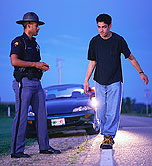
FRIDAY, Aug. 20 (HealthDay News) — The way that alcohol impairs reasoning and problem-solving abilities may explain why some people feel they’re fit to drive even though they’re drunk, researchers say.
The study looked at how cognitive abilities, which affect thinking skills, are affected during both rising and declining levels of blood alcohol concentration (BAC). BAC is a measurement used to determine intoxication, usually for legal or medical purposes.
In the laboratory, participants consumed alcoholic drinks over an eight-hour period to bring their BAC up to 0.10 percent and then waited for their levels to return to a normal BAC.
As their BAC levels rose and then fell during the experiment, the participants were asked to describe their feelings of drunkenness and they were assessed on their ability to navigate a hidden maze learning task on a computer.
Sober young adults make few mistakes on this test. But in this experiment, errors increased dramatically with rising BAC levels and the rate of errors did not decline dramatically even when the participants said they felt less drunk, the study authors noted.
The type of cognitive functioning used in the computer test is important for driving skills and making judgments in terms of traveling through intersections or changing lanes, the researchers noted.
The findings show that executive function doesn’t recover as quickly after drinking as basic functions such as motor speed and information processing speed, said study leader Peter J. Snyder, vice president of research for Lifespan, a nonprofit health care system based in Providence, R.I.
“The subjective feeling that you are drunk does recover more quickly. This explains why so many individuals feel subjectively that they are able to get into a car and be able to drive and feel safe. But that subjective impression does not mesh with the actual recovery in terms of higher order executive functions,” Snyder said in a Lifespan news release.
In the United States, many states enforce a legal BAC limit of 0.08 to 0.10 percent. At those levels, a 16- to 20-year-old male driver’s risk of a crash is nearly 52 times greater than normal, according to the background information provided in the news release.
The study is published in the August issue of the journal Experimental and Clinical Psychopharmacology.
More information
The U.S. Centers for Disease Control and Prevention has more about impaired driving.

